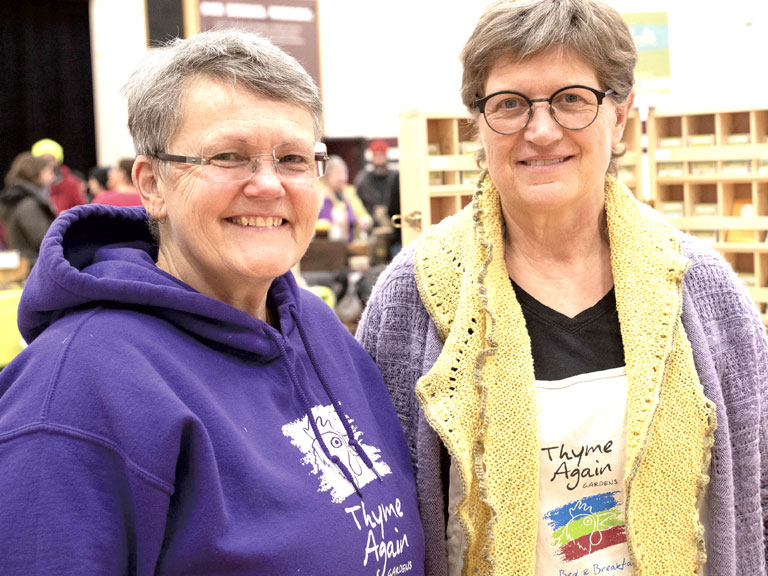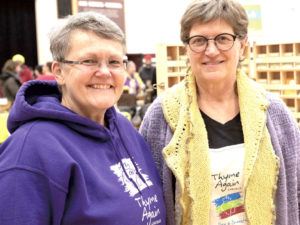County News
Seedy Saturday

Lure of seeds draws hundreds to PECI
Gardeners of all stripes leapt at the opportunity to get a jump on spring at the 11th annual Seedy Saturday event held on, appropriately, February 29—Leap Day. With 30 vendors to draw interest, a wellstocked seed swap table and a series of informative presentations, there was something for everyone. From organic vegetable seeds and heirloom tomatoes to gluten-free flour and fresh County maple syrup, all the bases were covered. There was a children’s area with plants available for potting, as well as a time for storytelling. Tamara Segal, one of the organizers of the event was thrilled with the attendance. “It’s another success. We’ve had a really great turnout, as big or bigger than any other year we’ve had the event,” she said. “This is a very grassroots event, run completely by volunteers. The only funding we get comes from donations at the event. We run on the energy of people who are willing to make it happen.”

(L-R): Lori Aselstine and Lorraine Schmid of Thyme Again Gardens offered a selection of organic seeds, honey and fresh County maple syrup.
This is one of over 150 Seedy Saturday events taking place across Canada in late winter or early spring, and the objective is to empower people to save seeds from their own gardens and share them with other likeminded people. “The benefit of saving seeds is that if you grow seeds in your own garden, then the plants adapt to your soil, and those the next year will be better adapted to the land and the micro-climate, so you end up with stronger plants that are more resilient,” said Ms. Segal. “Also we become more self-sustainable when we provide our own food starting with the seeds and moving all the way through to providing next year’s seeds. We don’t need to rely on anyone else to provide that for us, and it is really empowering.”
That theme of independence wound through each of the three classroom presentations. Robin Reilly spoke about the use of ground covers as a means of soil enrichment and insect control, and not having to rely on commercial fertilizers or pesticides. “Cover crops can be used for suppressing weeds, bringing nitrogen or phosphorous into the soil, for attracting beneficial insects,” he said. “You can think of cover crops as growing the soil, rather than growing vegetables. The simplest thing anyone with a garden can do is plant a cover crop, say oats, when you finish the harvest in October. With bare ground, the rain will wash away the nutrients in the soil. These plants will hold on to the nutrients all winter, and come spring those nutrients are available to you.” Lise Bois gave a presentation on companion planting, in which some plants offer protective qualities to others, such as attracting bees to help with pollination of fruit trees. Erica Gray and Cate Henderson gave a presentation about the Kenhte:ke seed sanctuary in Tyendinaga.
This houses a collection of over 300 seed varieties that were originally collected by the Mouk family in Napanee, and then passed on to the Sisters of Providence of Saint Vincent de Paul in Kingston. The seeds are a mix of heirloom varieties brought over by early settlers as well as seeds indigenous to this area, including beans and tobacco. The Sisters took care of the seeds for 20 years before passing custody along to Kenhte: ke in a ceremony that included the making of a wampum belt to mark this as a significant cultural process. Ms. Gray opened the presentation with a welcome in Kanyen’kéha (Mohawk language) that is known as the Words That Come Before All Else, and is an expression of gratitude for the gifts of the Earth. She then spoke about how important it was for the seeds to be “rematriated” to the Indigenous people. “It is important to save these seeds, first and foremost, because we have a relationship with them,” she said. “As part of our bargain with the seeds they provide us with food, and we help save them and keep them going.” The seed sanctuary has a small garden and will plant and save seeds for about 30 to 40 varieties each year on a rotation. Any extra seeds from the harvest will be distributed to community groups.

Comments (0)